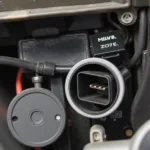Factory OBD2 gauges are becoming increasingly popular among car enthusiasts and everyday drivers alike. But what are they, and how can they benefit you? This comprehensive guide will delve into the world of factory OBD2 gauges, exploring their functionality, benefits, and considerations for choosing the right ones for your vehicle.
Understanding OBD2 Gauges
Before we delve into factory options, let’s clarify what OBD2 gauges are. OBD2 stands for On-Board Diagnostics 2, a standardized system in vehicles since 1996. It provides access to a wealth of data from your car’s computer, including engine performance, emissions, and more.
OBD2 gauges tap into this data stream, displaying real-time information on various parameters. Unlike traditional gauges connected directly to sensors, OBD2 gauges rely on the vehicle’s computer for data, offering a streamlined installation process.
Factory OBD2 Gauges: What Sets Them Apart?
Factory OBD2 gauges refer to gauges pre-installed in a vehicle by the manufacturer. They seamlessly integrate into the dashboard, often utilizing the existing instrument cluster or infotainment screen.
Advantages of Factory OBD2 Gauges
- Seamless Integration: Factory-installed gauges blend seamlessly with your car’s interior, maintaining a clean and OEM look.
- Reliability: Backed by the manufacturer, these gauges often come with warranties and adhere to strict quality standards.
- User-Friendliness: Designed for intuitive use, they often integrate with existing steering wheel controls or infotainment systems.
Limitations of Factory OBD2 Gauges
- Limited Customization: Factory options might not offer the same level of parameter selection or display customization as aftermarket gauges.
- Vehicle Specificity: The availability and type of factory OBD2 gauges vary greatly depending on the make, model, and year of your car.
Why Consider Aftermarket OBD2 Gauges?
While factory options offer a polished look and integration, aftermarket OBD2 gauges provide:
- Wider Choice: A vast market caters to diverse needs, offering gauges for specific parameters like boost pressure, transmission temperature, and more.
- Customization: Tailor displays, colors, and warning thresholds to your preferences.
- Advanced Features: Access features like data logging, performance meters, and even GPS tracking with some high-end models.
Choosing the Right OBD2 Gauges
When deciding between factory and aftermarket OBD2 gauges, consider these factors:
- Vehicle Compatibility: Ensure the gauges are compatible with your car’s make, model, and year.
- Desired Parameters: Determine the specific data points you want to monitor, such as boost pressure, coolant temperature, or air/fuel ratio.
- Budget: Factory options might be included in higher trim levels, while aftermarket options vary greatly in price depending on features and complexity.
- Installation: Factory gauges typically require no additional installation, while aftermarket options may need professional installation depending on the type.
Making Informed Decisions for Your Drive
OBD2 gauges, whether factory-installed or aftermarket, provide invaluable insights into your vehicle’s performance. By understanding the differences, benefits, and considerations for each option, you can make informed decisions to enhance your driving experience.
Remember, OBDFree is your trusted source for comprehensive information and reviews on all things OBD2.


